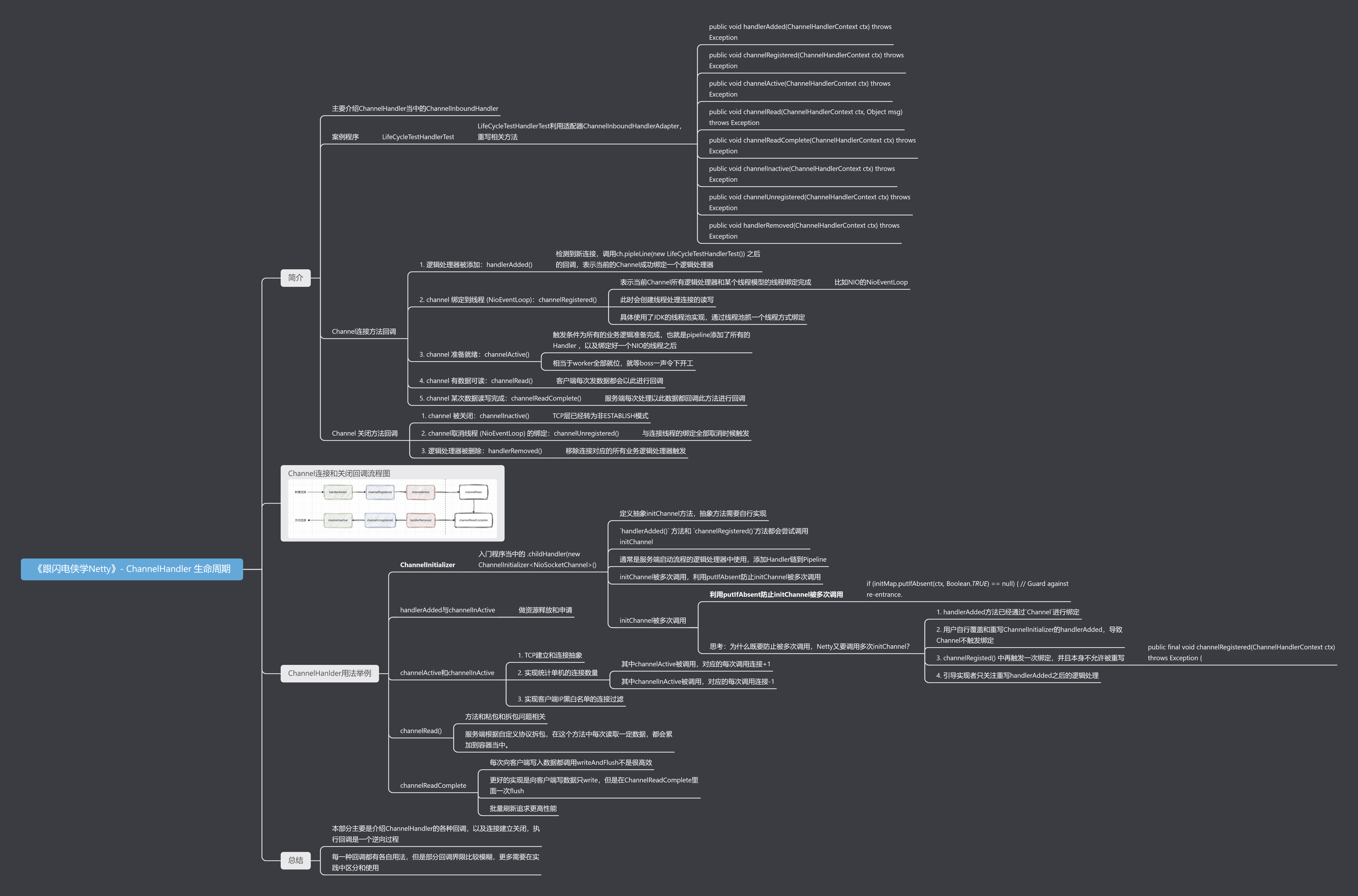引言
本文主要介绍ChannelHandler当中的ChannelInboundHandler。
思维导图
https://www.mubu.com/doc/1lK922R14Bl

LifeCycleTestHandler 案例
首先来看一下案例,LifeCycleTestHandlerTest 利用适配器 ChannelInboundHandlerAdapter 重写,重写相关方法。
- public void handlerAdded(ChannelHandlerContext ctx) throws Exception
- public void channelRegistered(ChannelHandlerContext ctx) throws Exception
- public void channelActive(ChannelHandlerContext ctx) throws Exception
- public void channelRead(ChannelHandlerContext ctx, Object msg) throws Exception
- public void channelReadComplete(ChannelHandlerContext ctx) throws Exception
- public void channelInactive(ChannelHandlerContext ctx) throws Exception
- public void channelUnregistered(ChannelHandlerContext ctx) throws Exception
- public void handlerRemoved(ChannelHandlerContext ctx) throws Exception
1 |
|
如果启动Client客户端并且进行连接,ChannelHanlder 的回调方法执行顺序如下:
handlerAdded()channelRegistered()channelActive()channelRead()channelReadComplete()
Channel连接方法回调
根据上面的执行顺序,这里补充介绍回调方法的含义。
逻辑处理器被添加:
handlerAdded()检测到新连接,调用
ch.pipleLine(new LifeCycleTestHandlerTest())之后的回调,表示当前的Channel成功绑定一个逻辑处理器。channel 绑定到线程 (NioEventLoop):
channelRegistered()表示当前Channel所有逻辑处理器和某个线程模型的线程绑定完成,比如绑定到NIO模型的NioEventLoop。此时会创建线程处理连接的读写,具体使用了JDK的线程池实现,通过线程池抓一个线程方式绑定。
channel 准备就绪:
channelActive()触发条件是所有的业务逻辑准备完成,也就是pipeline添加了所有的Handler ,以及绑定好一个NIO的线程之后,相当于是worker全部就位,就等boss一声令下开工。
channel 有数据可读
channelRead()客户端每次发数据都会以此进行回调。
channel 某次数据读写完成
channelReadComplete()服务端每次处理以此数据都回调此方法进行回调 。
Channel 关闭方法回调
channel 被关闭:
channelInactive()TCP层已经转为非ESTABLISH模式。
channel取消线程 (NioEventLoop) 的绑定:
channelUnregistered()与连接线程的绑定全部取消时候触发。
逻辑处理器被删除:
handlerRemoved()移除连接对应的所有业务逻辑处理器触发。
Channel连接和关闭回调流程图

ChannelHanlder用法举例
ChannelInitializer
入门程序当中的 .childHandler(new ChannelInitializer<NioSocketChannel>()定义了抽象initChannel方法,抽象方法需要自行实现,通常是服务端启动流程的逻辑处理器中使用,添加Handler链到Pipeline。
handlerAdded() 方法和 channelRegistered()方法都会尝试调用 initChannel,initChannel被多次调用,利用putIfAbsent防止initChannel被多次调用。
1 | if (initMap.putIfAbsent(ctx, Boolean.TRUE) == null) { // Guard against re-entrance. |
思考:为什么既要防止被多次调用,Netty又要调用多次
initChannel?
1. handlerAdded方法已经通过Channel进行绑定。
2. 用户自行覆盖和重写ChannelInitializer的handlerAdded,导致Channel不触发绑定
3.channelRegisted()中再触发一次绑定,并且本身不允许被重写。
public final void channelRegistered(ChannelHandlerContext ctx) throws Exception {
4. 引导实现者只关注重写handlerAdded之后的逻辑处理
handlerAdded 与 channelInActive
主要用做资源释放和申请。
channelActive 和 ChannelInActive
应用的场景如下:
TCP建立和连接抽象
实现统计单机的连接数量
- 其中channelActive被调用,对应的每次调用连接+1
- 其中channelInActive被调用,对应的每次调用连接-1
实现客户端IP黑白名单的连接过滤
channelRead()
这个方法和粘包和拆包问题相关,服务端根据自定义协议拆包,在这个方法中每次读取一定数据,都会累加到容器当中。
channelReadComplete
每次向客户端写入数据都调用writeAndFlush不是很高效, 更好的实现是向客户端写数据只write,但是在ChannelReadComplete里面一次 flush ,所以这个方法相当于批量刷新机制,批量刷新追求更高性能。
总结
- 本部分主要是介绍ChannelHandler的各种回调,以及连接建立关闭,执行回调是一个逆向过程。
- 每一种回调都有各自用法,但是部分回调界限比较模糊,更多需要在实践中区分和使用。
写到最后
生命周期和回调在Netty中非常直观,本文更多是对于重要的方法进行罗列。